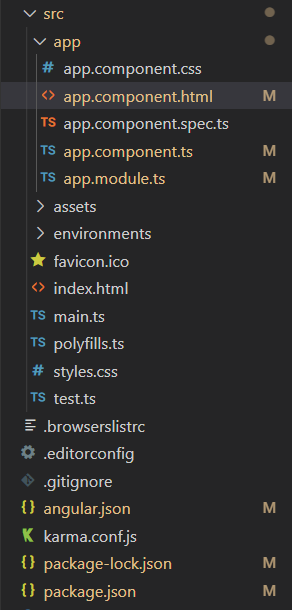Angular PrimeNG Button Basic Component
Last Updated :
15 Aug, 2022
Angular PrimeNG is an open-source front-end UI library that has many native Angular UI components which help developers to build a fast and scalable web solution. In this article, we will see Angular PrimeNG Button Basic Component.
A Button component is used for carrying out some action when clicked. The basic button refers to the simplest button provided by PrimeNG. These basic buttons are a simple button, a disabled button, and a link button.
Angular PrimeNG Button Basic Component Properties:
- label: The label property is used to set the text of the button component.
- disabled: This is an optional boolean property used to disable a button.
Angular PrimeNG Button Basic Component Styling:
- p-button-link: This class is used to style the button as a link.
Syntax:
<button pButton
type="button"
disabled="true | false"
label="..."
class="...">
</button>
Creating Angular Application and Installing the Module:
Step 1: Create an Angular application using the following command.
ng new appname
Step 2: After creating your project folder i.e. appname, move to it using the following command.
cd appname
Step 3: Finally, Install PrimeNG in your given directory.
npm install primeng --save
npm install primeicons --save
The project Structure will look like this after following the above steps:

Project Structure
Run the below command to see the output.
ng serve --open
Example 1: This example shows the use of the Angular PrimeNG Button Basic Component using the simple, disabled, and link buttons.
app.component.html
<div class="header">
<h2>GeeksforGeeks</h2>
<h3>Angular PrimeNG Button Basic Component</h3>
</div>
<div class="buttons">
<button pButton type="button"
label="Simple Button">
</button>
<button pButton type="button"
label="Disabled Button" disabled="true">
</button>
<button pButton type="button"
label="Link Button" class="p-button-link">
</button>
</div>
|
app.component.css
div{
display: flex;
align-items: center;
justify-content: center;
flex-direction: column;
}
.header h2{
margin-bottom: 0;
color: green;
}
button{
margin-bottom: 10px;
}
|
app.component.ts
import { Component } from '@angular/core';
@Component({
selector: 'app-root',
templateUrl: './app.component.html',
styleUrls: ['./app.component.css'],
})
export class AppComponent {}
|
app.module.ts
import { NgModule } from '@angular/core';
import { BrowserModule } from '@angular/platform-browser';
import { BrowserAnimationsModule }
from '@angular/platform-browser/animations';
import { AppComponent } from './app.component';
import {ButtonModule} from 'primeng/button'
@NgModule({
declarations: [
AppComponent
],
imports: [
BrowserModule,
ButtonModule,
BrowserAnimationsModule
],
providers: [],
bootstrap: [AppComponent]
})
export class AppModule { }
|
Output:
Example 2: This is another example that shows the use of Angular PrimeNG Button Basic Component using different colors.
app.component.html
<div class="header">
<h2>GeeksforGeeks</h2>
<h3>Angular PrimeNG Button Basic Component</h3>
</div>
<div class="buttons">
<button
pButton
type="button"
label="Simple Button"
class="p-button-secondary">
</button>
<button
pButton
type="button"
label="Simple Button"
class="p-button-warning">
</button>
<button
pButton
type="button"
label="Simple Button"
class="p-button-info">
</button>
<button
pButton
type="button"
label="Disabled Button"
class="p-button-success"
disabled="true">
</button>
<button
pButton
type="button"
label="Disabled Button"
class="p-button-danger"
disabled="true">
</button>
<button
pButton
type="button"
label="Disabled Button"
class="p-button-help"
disabled="true">
</button>
<button
pButton
type="button"
label="Link Button"
class="p-button-link">
</button>
</div>
|
app.component.css
div{
display: flex;
align-items: center;
justify-content: center;
flex-direction: column;
}
.header h2{
margin-bottom: 0;
color: green;
}
button{
margin-bottom: 10px;
}
|
app.component.ts
import { Component } from '@angular/core';
@Component({
selector: 'app-root',
templateUrl: './app.component.html',
styleUrls: ['./app.component.css'],
})
export class AppComponent {}
|
app.module.ts
import { NgModule } from '@angular/core';
import { BrowserModule } from '@angular/platform-browser';
import { BrowserAnimationsModule }
from '@angular/platform-browser/animations';
import { AppComponent } from './app.component';
import {ButtonModule} from 'primeng/button'
@NgModule({
declarations: [
AppComponent
],
imports: [
BrowserModule,
ButtonModule,
BrowserAnimationsModule
],
providers: [],
bootstrap: [AppComponent]
})
export class AppModule { }
|
Output:
Reference: http://primefaces.org/primeng/button
Like Article
Suggest improvement
Share your thoughts in the comments
Please Login to comment...